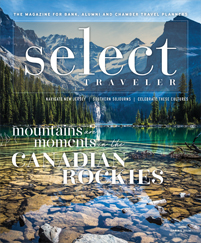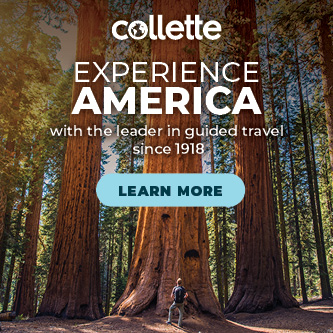“Bear!”
The cry made me instantly whirl around to scan the woods for signs of the elusive animal through the motorcoach window. Knowing that Glacier National Park claimed a healthy bear population, I had been hoping for the thrill of seeing one in the wild.
Soon not one, but three black bears appeared in the forest only a few feet from me. From the safety of the bus, I watched as the enormous mama bear stood next to her two smaller cubs. The two cubs practiced climbing up and down a pair of trees, a scene normally reserved for the pages of National Geographic.
The encounter was a dynamite introduction to the famed Montana park. I explored the picturesque region in June during a tour of Glacier National Park and the surrounding area with Western Leisure Tours.
Throughout the tour, I felt constantly connected to the larger-than-life nature all around me. The tour never strayed far from clear rivers, reflective lakes and colossal mountains thriving with flora and fauna.
Starting in Spokane
Before reaching Glacier National Park, my tour began in Spokane, Washington. The charming town perched on the eastern edge of Washington proved an excellent place for an afternoon stroll along the Spokane River.
From the Lion River Inn, I followed a paved route past manicured gardens to Riverfront Park. Carousels, food stands, live music and a 1902 clock tower created a festive and relaxing downtown atmosphere. Numerous locals wandered around the shady park with me, taking advantage of the blue sky and blooming spring flowers.
The next morning, my group departed Washington for Wallace, Idaho. The old mine town lies snugly enclosed by the foothills of the Bitterroot Mountains, an area mined heavily for silver.
From the historic downtown, we took a trolley to the Sierra Silver Mine Tour. Originally, the 130-year-old mine extracted gold and silver; it then became a school for miners, which eventually closed. Today, the tunnels serve as one of the most popular tours in Idaho.
After donning a hard hat, we followed Lenny, a retired-miner-turned-guide, into the dark entrance of the mine’s 250 miles of tunnels.
Lenny gave a moving firsthand account of working in a mine. He flashed a mischievous grin while talking about old mining pranks; his face took on a serious expression while he revealed the hardships of day-to-day mining life,
“Maybe this is something you all don’t want to know, but right now, we are 600 feet below the mountain,” said Lenny. “To understand what it was like for miners, you have to remember that when I worked in the mines, it wasn’t anything like this. Imagine working all week in tiny tunnels with no light except your headlamp. My partner and I, working next to each other, might not see each other until the end of the shift.”
To demonstrate the pitch-black miner experience, Lenny turned off the electric lights so only his headlamp shone through the heavy darkness. Lenny also demonstrated some of the mining machinery on display to reveal the extremely loud conditions miners experienced.
After returning to daylight, I discovered another profession I did not envy at the Aerial Fire Depot and Smokejumper Center near Missoula, Montana. The site honors the insanely brave smokejumpers who, instead of fleeing a raging wildfire, parachute into its path, miles away from civilization.
“Smokejumpers go straight into the fires that you can’t drive to,” said Jennifer, our guide. “The mountains without roads in Montana cover [an area as large as] the state of Maryland. Their gear weighs up to 115 pounds because they have to pack with equipment and food for three days because they have to hike back out.”
My attempt to move one of the bags those heroes carried with them while fighting fires failed entirely. The site’s behind-the-scenes tour of where the smokejumpers worked inspired complete admiration for the brave men and women who volunteered to keep the region safe.
Beauty by Man and Nature
I stepped inside a simple brick church not knowing what I would find inside. St. Ignatius Mission, the second-oldest mission in Montana, thoroughly surprised me with its beautiful features: eggshell walls, colorful light and intricate wall murals. The story behind the 1893 church’s 58 murals made me like them all the more because they were created by the mission’s cook as part of the church’s ministry to the local Native Americans.
We left this little-known treasure for the wide-reaching vistas of Glacier National Park at its West Glacier entrance. I soaked up the park’s fresh air and views of mammoth mountains while on a scenic float trip down the Flathead River.
The 10-mile ride flew by as my group gazed up at snow-capped peaks and paddled periodically. My guide shared some of the history of the area while directing us on how to avoid the river’s few small rapids.
“Here we have a few waves coming up but nothing you all can’t handle,” Shea, our Glacier Raft Company guide, said confidently.
After the soul-cleansing raft ride, the motorcoach rode past more of the park’s wildlife and steep mountains to arrive at Many Glacier Hotel. It seemed difficult to imagine a more scenic location for the Swiss-style hotel than its current spot on the shores of Swiftcurrent Lake surrounded by giant stone mountains. Inside, the 1915 chalet kept up its Old World style with charming architectural details and spacious windows so guests would never forget their secluded mountain locale.
The next morning, my group boarded the hotel’s sightseeing boat for a cruise across the turquoise lake. As the hotel appeared to become smaller behind us, being dwarfed by the jutting mountains around it, our cruise guide, Kara, related the history of the National Historic Landmark.
“The only way to get to Many Glacier Hotel when it was first built was by railroads,” Kara said. “There were chalets throughout the park that took two weeks to reach. Now it only takes an average of three hours.”
We hiked the short distance to Lake Josephine for another lake cruise past glaciers and the cascading Grinnell Falls. Gazing up at the colorful mountains touching the sky, it seemed impossible to imagine the enormity of the glaciers that carved the jagged landscape.
Following the cruise, I hiked to nearby Apikuni Falls. The abundance and variety of wildflowers amazed me, as did the powerful waterfall, which I could hear before I could see it.
Zen-like, I retired to the hotel to eat a delicious salmon dinner and watch the red-hued mountain sunset.









